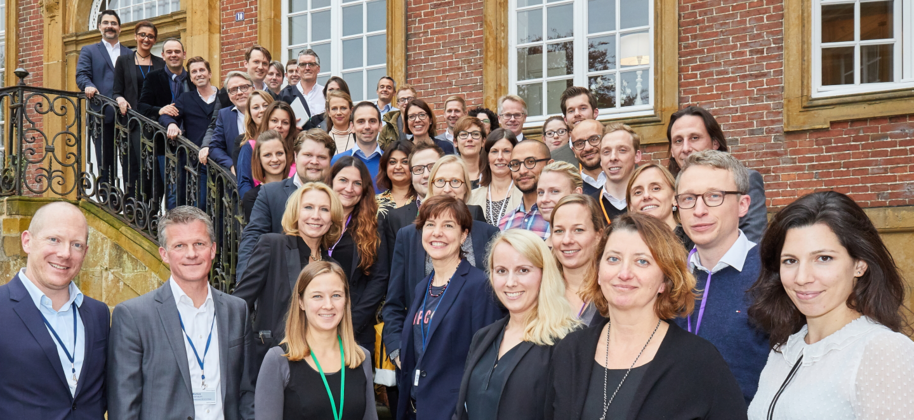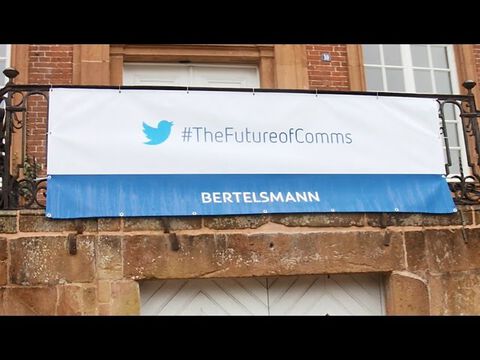 What will communication look like ten years from now? What media and devices will we be using? How “real” will virtual interaction be? Given that just ten years ago, the smartphone and hence its revolutionary impact on communications – now available anytime, anywhere – did not even exist, it would of course be unrealistic to expect answers to these questions today. And yet, it is nevertheless possible and necessary to think about them. Which is exactly what 30 communications department colleagues from eight countries and across all divisions did last week. In the 800-year-old Marienfeld monastery just outside Gütersloh, Bertelsmann Corporate Communications and Bertelsmann University hosted their first “The Future of Comms” bootcamp, where a group that was as dedicated as it was creative spent two days developing future scenarios for corporate communications.
What will communication look like ten years from now? What media and devices will we be using? How “real” will virtual interaction be? Given that just ten years ago, the smartphone and hence its revolutionary impact on communications – now available anytime, anywhere – did not even exist, it would of course be unrealistic to expect answers to these questions today. And yet, it is nevertheless possible and necessary to think about them. Which is exactly what 30 communications department colleagues from eight countries and across all divisions did last week. In the 800-year-old Marienfeld monastery just outside Gütersloh, Bertelsmann Corporate Communications and Bertelsmann University hosted their first “The Future of Comms” bootcamp, where a group that was as dedicated as it was creative spent two days developing future scenarios for corporate communications.
 “Bertelsmann, its divisions and its businesses are well perceived by employees, the media and the general public today, and get a lot of recognition. This is reflected in high usage figures, prestigious awards and top positions in many rankings. We want to keep it this way,” says Karin Schlautmann, Head of Bertelsmann Corporate Communications. “So, from this position of strength, we teamed up with Bertelsmann University to create a new format called ‘The Future of Comms’. We wanted to generate new ideas for future communications work, to highlight the opportunities of new channels and technologies for our work, and to integrate young colleagues into the conceptual evolution of communications work. I’m pleased that we have achieved all these goals with ‘The Future of Comms’.”
“Bertelsmann, its divisions and its businesses are well perceived by employees, the media and the general public today, and get a lot of recognition. This is reflected in high usage figures, prestigious awards and top positions in many rankings. We want to keep it this way,” says Karin Schlautmann, Head of Bertelsmann Corporate Communications. “So, from this position of strength, we teamed up with Bertelsmann University to create a new format called ‘The Future of Comms’. We wanted to generate new ideas for future communications work, to highlight the opportunities of new channels and technologies for our work, and to integrate young colleagues into the conceptual evolution of communications work. I’m pleased that we have achieved all these goals with ‘The Future of Comms’.”
Steven Moran, who is responsible for Bertelsmann University as Chief Learning Officer, adds: “‘The Future of Comms’ was uncharted territory for us, too. It was the University’s first vocational training program specifically on the topic of communications, though we were able to draw on our experience with the successful Creativity Bootcamps in terms of methodology. As for the selection of the participants, we deliberately refrained from applying hierarchical criteria this time and asked the divisions to nominate colleagues whose work specifically involves new forms of and challenges in communications at Bertelsmann. The recipe worked, and the intensive networking between participants showed that we all face the same challenges and can best resolve them together.”
 The intensive workshop work began in advance for the 30 participants of “The Future of Comms”: For one, they interviewed a coworker or supervisors on questions about the future of communication, and for another, on Twitter (#TheFutureOfComms) where they interacted in advance, but then much more intensively during the course of the meeting itself. From coffee break donuts to charts and sketches from the “workbench,” to photos, everything was tweeted on the social network and ensured that among other things, Thomas Rabe himself responded on Twitter, declaring that he was “excited to see the results and new ideas from the workshop.”
The intensive workshop work began in advance for the 30 participants of “The Future of Comms”: For one, they interviewed a coworker or supervisors on questions about the future of communication, and for another, on Twitter (#TheFutureOfComms) where they interacted in advance, but then much more intensively during the course of the meeting itself. From coffee break donuts to charts and sketches from the “workbench,” to photos, everything was tweeted on the social network and ensured that among other things, Thomas Rabe himself responded on Twitter, declaring that he was “excited to see the results and new ideas from the workshop.”
 In Marienfeld, a former monastery that dates from the 12thcentury and now houses a hotel, the communications colleagues enjoyed the deliberate contrast between monastery walls and vaulted beams on the one hand and the development of future scenarios on the other. After an introductory overview of the numerous innovations in Bertelsmann’s communications over the past four years – on which the aspiration to shape the future of communications at Bertelsmann is based – Dieter Georg Herbst, a Professor at St. Gallen and Berlin, took to the stage for the opening keynote of “The Future of Comms.”
In Marienfeld, a former monastery that dates from the 12thcentury and now houses a hotel, the communications colleagues enjoyed the deliberate contrast between monastery walls and vaulted beams on the one hand and the development of future scenarios on the other. After an introductory overview of the numerous innovations in Bertelsmann’s communications over the past four years – on which the aspiration to shape the future of communications at Bertelsmann is based – Dieter Georg Herbst, a Professor at St. Gallen and Berlin, took to the stage for the opening keynote of “The Future of Comms.”
Herbst began by addressing the conventional wisdom of new media meaning information overload. “The opposite is the case,” said the academic. “People are always open to new things. They have to be - but they filter out what information is relevant for them and what isn’t.” Often, this is done on the basis of emotion - and almost always within less than three seconds. Speaking to the communications experts, he concluded, “you only have these few seconds to reach a person with your information and messages.” That is why it is becoming increasingly important to work with readily accessible images and self-contained stories, no matter how short, said Herbst.
 Inspired by the keynote and moderated by three trainers from the Swiss agency Denkmotor headed by Jiri Scherer, the participants set to work. In six mixed workshop groups, they developed scenarios for communicating various fictitious events in 2026. From seven proposals, they chose three for this task: The product communication of the first entire online-first series broadcast by the French channel M6; event communications for the first Bertelsmann Party in New York; and finally, the communication of a digital strategy ten years from now. In developing the scenarios, several megatrends that had previously been outlined together played a decisive role, for example, the emotionalizing of communication, the increased use of video and images, and the possibility of direct communication via social media, bypassing traditional mass media.
Inspired by the keynote and moderated by three trainers from the Swiss agency Denkmotor headed by Jiri Scherer, the participants set to work. In six mixed workshop groups, they developed scenarios for communicating various fictitious events in 2026. From seven proposals, they chose three for this task: The product communication of the first entire online-first series broadcast by the French channel M6; event communications for the first Bertelsmann Party in New York; and finally, the communication of a digital strategy ten years from now. In developing the scenarios, several megatrends that had previously been outlined together played a decisive role, for example, the emotionalizing of communication, the increased use of video and images, and the possibility of direct communication via social media, bypassing traditional mass media.
 On the evening of the first day of the seminar, the “Future of Comms” participants were able to form their own picture of what this direct, interactive communication of the future might look like. In a digital exhibition specially assembled for the occasion, they were able to see and move holograms using Microsoft’s brand-new Hololens, drive a Samsung Gear VR Porsche, and try out the HTC Vive and Oculus Rift. The market maturity and widespread use of such devices may still be the stuff of dreams, but the participants were convinced that they will soon have a massive impact on the future of communications.
On the evening of the first day of the seminar, the “Future of Comms” participants were able to form their own picture of what this direct, interactive communication of the future might look like. In a digital exhibition specially assembled for the occasion, they were able to see and move holograms using Microsoft’s brand-new Hololens, drive a Samsung Gear VR Porsche, and try out the HTC Vive and Oculus Rift. The market maturity and widespread use of such devices may still be the stuff of dreams, but the participants were convinced that they will soon have a massive impact on the future of communications.
Accordingly, the fact that communications in the future will depend essentially on new technological possibilities was a common theme that ran through all six final presentations. Besides Karin Schlautmann and the Corporate Communications management team, the heads of Corporate Communications from several divisions came to Marienfeld: Oliver Fahlbusch (RTL Group), as well as Gernot Wolf and Matthias Wulff, representing Arvato and the Printing Group, and they quickly entered into an intensive discussion with the “The Future of Comms” participants.
 In their presentations all the groups expressed their conviction that big data will enable new forms of custom targeting and will therefore have a great impact on corporate communications – and that there will be new target groups for external communications beyond journalists, such as bloggers or other influencers, if this isn’t already the case. The groups were creative, presenting “Bini,” a smart, data-based and personalized virtual assistant who will help Bertelsmann employees with their routine work in 2026, and “Story X,” a box into which all the company’s content and information is fed and then automatically custom-compiled for forwarding to external or internal multipliers.
In their presentations all the groups expressed their conviction that big data will enable new forms of custom targeting and will therefore have a great impact on corporate communications – and that there will be new target groups for external communications beyond journalists, such as bloggers or other influencers, if this isn’t already the case. The groups were creative, presenting “Bini,” a smart, data-based and personalized virtual assistant who will help Bertelsmann employees with their routine work in 2026, and “Story X,” a box into which all the company’s content and information is fed and then automatically custom-compiled for forwarding to external or internal multipliers.
“It was great to see the groups’ commitment and creativity as they worked on their future scenarios, though I believe that some of these scenarios will become a reality well before 2026,” concluded Karin Schlautmann. “In any case, the participants and the Communications team have shown together that they are willing and able to shape the future of communications at Bertelsmann.” (benet)
